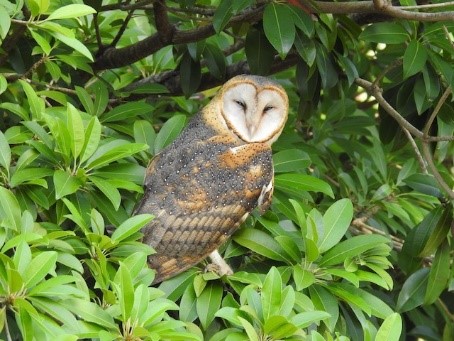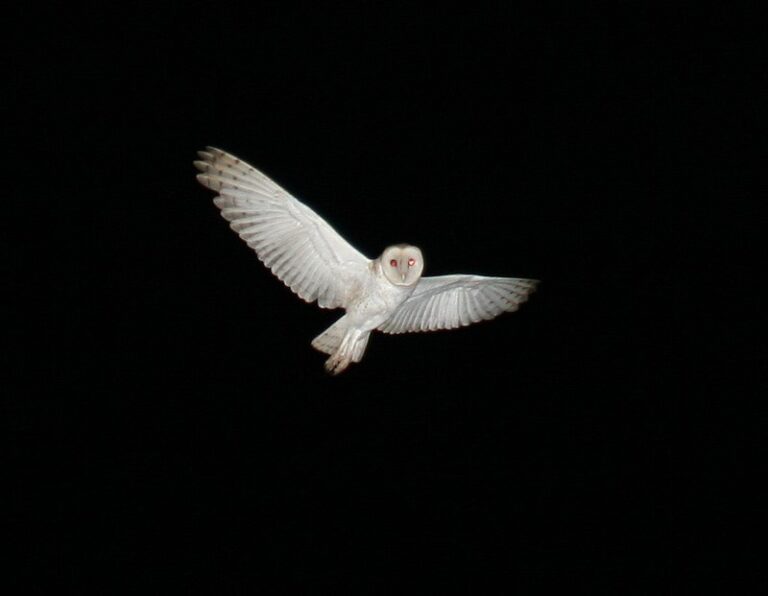Birdfinding.info ⇒ The Curaçao endemic form of the American Barn Owl is naturally rare and strictly nocturnal. It can sometimes be seen at known day-roosts, especially around dusk. One such roost that has produced regular sightings is a small cave in the Koraal Tabac area just east of the Willemstad’s Santa Catharina neighborhood.
“Curaçao Barn Owl”
Tyto furcata bargei
Endemic to Curaçao, where it is known mainly from limestone cliffs with caves suitable for roosting and nesting, but presumably occurs throughout the small island. In 2001, the population was estimated at 75 adults.
Identification
A small insular barn owl that is probably not visually differentiable from continental populations of American Barn Owl, but which measures ~75-80% as large in both wingspan and overall length.

“Curaçao Barn Owl”, T. f. bargei. © Léon Pors
Judging from the few published photos, the “Curaçao Barn Owl” tends to have largely gray upperparts and white underparts, often with extensive black speckles.

“Curaçao Barn Owl”, T. f. bargei, a pale male. (Koraal Tabac, Curaçao; June 16, 2020.) © Rob Kelder
The only owl known from Curaçao, though barn owls from Bonaire and Venezuela might wander there from time to time.

“Curaçao Barn Owl”, T. f. bargei, showing extensively gray upperparts. (Seru Grandi, Curaçao; July 21, 2017.) © Robert Wellens

“Curaçao Barn Owl”, T. f. bargei, ventral view in flight showing essentially all-white underparts and underwings. (Sunset Height, Curaçao; June 19, 2006.) © Mars Muusse
Voice. The “Curaçao Barn Owl’s” vocalizations are not well-documented in publicly available recordings. They are known to include shrill territorial screams, and metallic chirps given in flight: e.g., Sorsaka Public Park, August 17, 2023. © Quinlan Cijntje
Notes
Monotypic form, one of four potentially distinct forms of the American Barn Owl (T. furcata). Traditionally classified as a subspecies of the Barn Owl (T. alba).
Both recent guidebooks to the owls of the world, König and Weick (2008) and Mikkola (2012), recognize the “Curaçao Barn Owl” as a separate species, based primarily on its size: i.e., measurements ~75-80% of those of the widespread continental form.
References
Aliabadian, M., N. Alaei-Kakhki, O. Mirshamsi, V. Nijman, and A. Roulin. 2016. Phylogeny, biogeography, and diversification of barn owls (Aves: Strigiformes). Biological Journal of the Linnean Society 119:904-918.
BirdLife International. 2019. Tyto alba (amended version of 2016 assessment). The IUCN Red List of Threatened Species 2019: e.T22688504A155542941. https://dx.doi.org/10.2305/IUCN.UK.2019-3.RLTS.T22688504A155542941.en. (Accessed September 28, 2023.)
eBird. 2023. eBird: An online database of bird distribution and abundance. Cornell Lab of Ornithology, Ithaca, N.Y. http://www.ebird.org. (Accessed September 28, 2023.)
Enríquez, P.L., K. Eisermann, H. Mikkola, and J.C. Motta-Junior. 2017. A Review of the Systematics of Neotropical Owls (Strigiformes), in Neotropical Owls: Diversity and Conservation (P.L. Enríquez, ed.). Springer International Publishing, Cham, Switzerland.
iNaturalist. 2023. https://www.inaturalist.org/. (Accessed September 28, 2023.)
König, C., and F. Weick. 2008. Owls of the World (Second Edition). Yale University Press.
Mikkola, H. 2013. Owls of the World: A Photographic Guide (Second Edition). Firefly Books, London.
Wells, J.V., and A.C. Wells. 2017. Birds of Aruba, Bonaire, and Curaçao. Cornell University Press, Ithaca, N.Y.
Wink, M., P. Heidrich, H. Sauer-Gurth, A. El-Sayed, and J. González. 2008. Molecular phylogeny and systematics of owls (Strigiformes), in Owls of the World (C. König and F. Weick, eds.). Christopher Helm, London.
